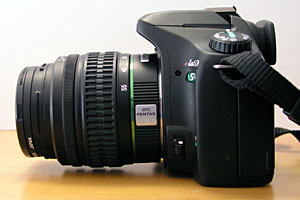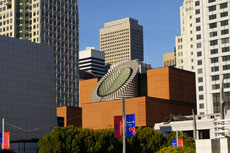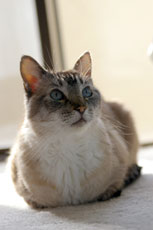|
|||||||||
Advertisement |
Pentax *ist DS 6.1 Megapixel Digital SLR Camera
Page 2, continued from page
1 Image Resolution and Quality The *ist DS takes superb shots, with excellent sharpness and extremely high color accuracy. Image resolution was very high in our tests, equaling the Digital Rebel's and we noticed a bit less noise in the Pentax's shots, especially in shadows and in large expanses of blue sky. While some users felt the default sharpening on the *ist D was a bit soft, the *ist DS is plenty sharp (but not overdone) for prints up to 8" x 10". Of course, you can change the in-camera sharpening or use Photoshop's Unsharp Mask, and we used a light dose of USM for some 8" x 10" prints. Pentax' JPEG compression is impressive, and our images averaged 2.5 megs at the highest resolution and quality settings. Resolution in megapixels is only a part of the resulting image quality. The superior sensor on digital SLRs and better lenses (even a relatively cheap SLR lens is superior to fixed lenses found on all-in-one cameras) mean that the Pentax and other digital SLRs blow away photos from all-in-one digicams of the same resolution. See our sample photos below to get an idea of image quality. Noise at ISO 200 (default) and 400 was extremely low, 800 was quite low, 1600 was decent for that sensitivity and 3200 is actually usable. The *ist DS has the least noise of any camera in this price range and takes truly compelling shots up to ISO 800. Kit Lens The zoom lenses bundled with SLRs (digital or film) are never something to write home about. They're generally equivalent to $100 to $150 zooms purchased separately. They're not terrible (the manufacturer wouldn't want you to think your new camera took horrible photos), but you can always do better if you have the money to spend on a $350 zoom. That said, the included Pentax SMC DA 18-55mm f3.5-5.6AL lens is decent and has relatively low barrel distortion and pincushioning for a starter lens (see the SF MOMA architectural sample photo below). We did notice more noise with this lens than expected, though. The lens, equivalent to 28 - 85mm in 35mm film photography, is a "DA" lens designed and optimized for Pentax digital SLRs and will not work with film SLRs.
The Pentax *ist DS digital SLR with kit lens |
|
Is it worth it to buy the camera with the kit lens? If you don't have a good Pentax zoom already, and you don't have $300 or more to spend on a better lens, then definitely yes. It takes very pleasing shots, is optimized for the APS sensor size and will get you going right out of the box. If you do have a little more money to spend, some photography stores offer an alternate bundle with Pentax' higher end DA 16- 45mm f4 lens. Its faster fixed aperture will help with low light shots, and it exhibits less noise, though the tele end of the zoom is a little short for our tastes. I found that the Tamron SP AF28-75mm f2.8 Di LD aspherical (IF) macro lens, which sells for under $400 is an excellent companion to the *ist DS. This fast fixed aperture lens has excellent optics and corner sharpness, and is optimized for digital SLRs. However, the Tamron is not a light lens compared to the featherweight Pentax kit lens and it may not go wide enough to suit landscape photographers.
Advanced Shooting Features and Auto Pict
Those of you looking for point and shoot simplicity will adore Auto Pict. Slide the dial to Auto Pict and you'll be taking excellent photos with a press of the shutter button. Auto Pict takes uncannily good shots, setting the aperture and picture mode (i.e.: portrait, landscape, macro) based on available light and subject distance. In fact, it made the same decisions we'd have made most of the time; correctly identifying landscape, macro and portrait shots and setting an intelligent aperture and shutter speed.
The camera has five scene modes which you'll select using the dial: Normal, Portrait, Landscape, Macro, Moving Object (sports) and Night Scene Portrait. In addition you can chose Flash Off mode which disables the flash and uses the normal mode. As you'd expect on an SLR, the *ist DS has five standard program modes: P (program), Tv (shutter priority), Av (aperture priority), M (manual) and B (bulb). You can set EV compensation from -2 to +2 in 1/2 or 1/3 steps and use three shot autobracketing. The camera offers AE-lock, focus lock and has several white balance settings including manual.
The camera has four drive modes: single shot, continuous (approx. 2.8fps), self-timer, remote control (remote not included) and auto bracketing. Auto white balance works decently but wasn't at the top of the pack when it comes to tricky indoor shots and mixes of natural and incandescent light (photos are too warm). You can select from 6 other white balance presets: daylight, shade, cloudy, fluorescent, tungsten, flash or set white balance manually. To do so, select manual white balance from the Fn display and release the shutter while aiming the camera at a white or gray card (remember to change to manual focus as the lens will fail to focus on a blank background and you won't be able to release the shutter).
The pop-up flash works quite well and has good enough rise to avoid vignetting with all but very short wide angle and extremely long tele lenses (the manual has a table indicating lens comparability). The flash works well for subjects at a 2.2 to 12 foot range, and offers four modes: auto, manual (i.e.: fill flash or daylight sync), auto red-eye reduction and manual red-eye reduction. You can easily disable the flash when necessary or use an external flash in the hotshoe as well as external slave units. We found that the flash, which has guide number of 22 at ISO 400, provided a reasonable amount of fairly natural lighting for indoor scenes at night and the auto setting worked very well for tricky backlit and fill flash situations, yielding very balanced exposures.
Sample photos. Taken at maximum resolution and quality in JPEG format. Taken with kit lens unless noted. Click on an image to see the full size original. Warning: each original full size image is 2.5 megs.
|
|
Included Software Pentax includes their Photo Browser 2.0 application for Windows and Mac. With Photo Browser you'll be able to browse, save and print your photos. If you like to shoot in RAW format, you may indeed rely on the included Pentax Photo Laboratory 2.0 to work with your photos, or you can take your chances with Photoshop's RAW plugin. The software has a good feature set for working with RAW, so do give it a try if RAW is your thing. That said, JPEG photos come out so well with this camera, you may find yourself using it rather than RAW. The *ist DS has a USB 2.0 interface and comes with a cable for transferring images to your computer. Alternatively, you can use a card reader to transfer and browse your photos. In addition, the camera supports PictBridge for direct printing to a PictBridge enabled photo printer. Conclusion Definitely a winner! Perfect for serious photographers and beginners alike thanks to a full set of manual settings and program modes for the experienced photographer and Auto Pict mode for the newbies. In fact, Auto Pict works so well, experienced photographers will find themselves replying on it too. Pro: The camera is very compact and light, yet it's well-built and laid out. The metal body and stainless steel lens mount are an added bonus in a digital SLR in this price range. Wonderful photos of excellent resolution and color accuracy. Exceptionally low noise (even in JPEGs) and great shadow and highlight detail. Can shoot ISO 800 and get good shots, ISO 200 and 400 are to die for! Easy to find AA batteries mean you won't run out of juice on the road. Flash is well-balanced. Fast and accurate AF with Pentax and 3rd party lenses, including macros. Con: SD card slot won't thrill those with an extensive collection of CF cards. Auto and preset white balance could be better for indoor and mixed lighting shots. No program shift. Web site: www.pentaximaging.com List Price: ~ $999 with kit lens, $899 for body only. Comparison Shopping: Where to Buy
Specs:
|







